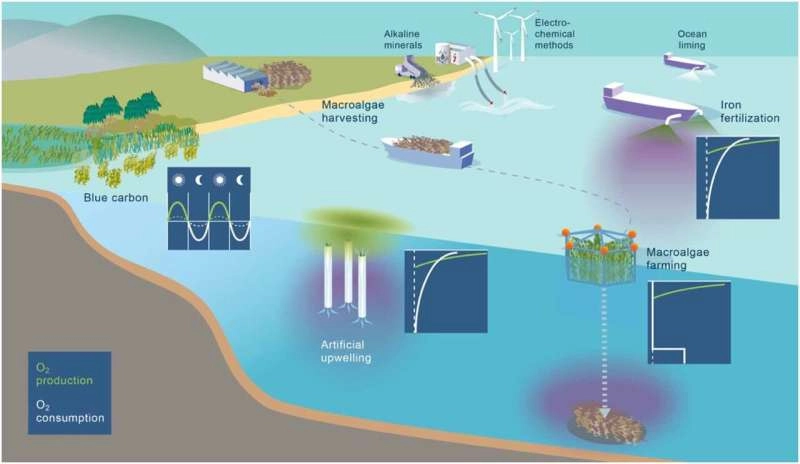Environmental Research Letters (2025). DOI: 10.1088/1748-9326/ade0d4>  Schematic of the different marine carbon dioxide removal (mCDR) methods discussed in this study. Pink shading indicates possible reduction in dissolved oxygen resulting from the respective open-ocean biotic mCDR activity via enhanced respiration in the water column, green shading for iron fertilization and artificial upwelling indicates fertilization-induced enhanced photosynthesis in the surface waters. Inserts indicate the mCDR-induced additional O2 production (green) and O2 consumption (white). Credit: Environmental Research Letters (2025). DOI: 10.1088/1748-9326/ade0d4
Schematic of the different marine carbon dioxide removal (mCDR) methods discussed in this study. Pink shading indicates possible reduction in dissolved oxygen resulting from the respective open-ocean biotic mCDR activity via enhanced respiration in the water column, green shading for iron fertilization and artificial upwelling indicates fertilization-induced enhanced photosynthesis in the surface waters. Inserts indicate the mCDR-induced additional O2 production (green) and O2 consumption (white). Credit: Environmental Research Letters (2025). DOI: 10.1088/1748-9326/ade0d4
Methods to enhance the ocean's uptake of carbon dioxide (CO�) are being explored to help tackle the climate crisis. However, some of these approaches could significantly exacerbate ocean deoxygenation. Their potential impact on marine oxygen must therefore be systematically considered when assessing their suitability.
An international team of researchers led by Prof. Dr. Andreas Oschlies from the GEOMAR Helmholtz Center for Ocean Research Kiel has analyzed the impact of marine carbon dioxide removal methods on global ocean oxygen levels. The findings were published yesterday in the journal Environmental Research Letters.
Global warming is the primary cause of the dramatic loss of oxygen in the oceanapproximately 2% of the ocean's oxygen inventory has been lost over the past decades, with serious ecological consequences already today. Any additional warming will lead to additional oxygen loss. One might therefore expect that climate mitigation measures would help to counteract oxygen decline. Yet the new study reveals that many proposed marine carbon dioxide removal (mCDR) methodsespecially those based on biological processescould in fact intensify oxygen loss in the ocean.
"What helps the climate is not automatically good for the ocean," says Prof. Dr. Oschlies, lead author of the study and head of the Biogeochemical Modeling research division at GEOMAR. Together with an international team that is part of the UNESCO Global Ocean Oxygen Network (GO2NE), he conducted the comprehensive assessment using idealized global model simulations to analyze both the direct impacts of various mCDR approaches on ocean oxygen and their indirect effects through climate mitigation.
The study identifies several biotic mCDR methods as particularly criticalincluding ocean fertilization, large-scale macroalgae farming followed by sinking of the biomass, and artificial upwelling of nutrient-rich deep water. These approaches involve the enhancement of photosynthetic biomass production, followed by its decomposition in the ocean interior. This remineralization process consumes oxygenat levels comparable to the current rate of global deoxygenation caused by ocean warming.
"Methods that increase biomass production in the ocean, and subsequently lead to oxygen-consuming decomposition, cannot be considered harmless climate solutions," says Prof. Dr. Oschlies. "Our model simulations show that such approaches could cause a decrease in dissolved oxygen that is 4 to 40 times greater than the oxygen gain expected from reduced global warming."
By contrast, geochemical mCDR approaches that do not involve nutrient inputsuch as ocean alkalinity enhancement through the addition of alkaline substances based on limestoneappear to have minimal effects on ocean oxygen levels and are comparable to simply reducing CO� emissions.
Among all methods examined, only large-scale macroalgae farming with biomass harvesting (i.e., removal from the ocean) resulted in an overall increase in oceanic oxygen levels. In this case, no additional oxygen is consumed within the marine environment, and the removal of nutrients limits oxygen consumption elsewhere.
Model results suggest that if deployed at sufficient scale, this approach could even reverse past oxygen lossesproviding up to 10 times more oxygen than has been lost due to climate change within a century. However, here it is the removal of nutrients that would negatively impact biological productivity in the ocean.
Discover the latest in science, tech, and space with over 100,000 subscribers who rely on Phys.org for daily insights. Sign up for our free newsletter and get updates on breakthroughs, innovations, and research that matterdaily or weekly.
Call for systematic monitoring of ocean oxygen
Given these findings, the authors advocate for mandatory inclusion of oxygen measurements in all future mCDR research and deployment efforts.
"The ocean is a complex system which is already heavily under pressure," says Prof. Dr. Oschlies. "If we intervene with large-scale measures, we must ensure that, no matter how good our intentions are, we are not further threatening marine environmental conditions that marine life depends on."
Carbon dioxide removal as part of climate strategy
Even with ambitious climate policy, Germany is expected to emit 10% to 20% of today's greenhouse gas levels in three decades' timecontinuing to drive global warming. Carbon dioxide removal (CDR) is therefore being considered to help reach net-zero emissions. The ocean is the key player in the global carbon cycle due to its natural CO2 uptake and its huge storage capacity.
However, these processes typically occur over long timescales. Marine carbon dioxide removal (mCDR) approaches aim to accelerate these natural processes, thereby increasing the ocean's carbon uptake capacity.
More information: Andreas Oschlies et al, Potential impacts of marine carbon dioxide removal on ocean oxygen, Environmental Research Letters (2025). DOI: 10.1088/1748-9326/ade0d4
Journal information: Environmental Research Letters
Citation: Carbon dioxide removal methods could worsen marine oxygen loss, study warns (2025, June 14) retrieved 16 June 2025 from https://phys.org/news/2025-06-carbon-dioxide-methods-worsen-marine.html
This document is subject to copyright. Apart from any fair dealing for the purpose of private study or research, no part may be reproduced without the written permission. The content is provided for information purposes only.



